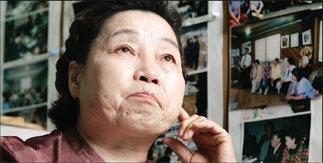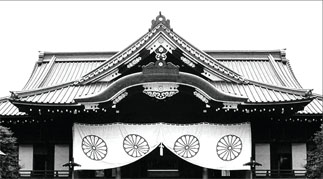One woman’s fight against war shrine

Lee Hee-ja still gets emotional when talking about her father, Lee Sa-hyun. By Kang Uk-hyu 아버지 이사현 씨를 이야기하며 울먹이는 이희자씨. 강욱현
For Lee Hee-ja, it is an important ritual to visit her father’s gravesite every few months to bring flowers and clean the tombstone. Yet the tombstone bears no epitaph on its gray stone tablet.
*epitaph: 비문
이희자씨에게 두 세 달에 한번씩 아버지의 무덤을 방문해 헌화하고 청소하는 것은 중요한 의식이다. 그러나 그 무덤에는 회색 묘비에 어떤 비문도 새겨져 있지 않다.

The Yasukuni Shrine in Tokyo is the major focus of Lee Hee-ja’s efforts as she tries to get her father’s name removed from the list of the enshrined. [JoongAng Ilbo] 도쿄의 야스쿠니 신사는 이희자씨가 아버지의 이름을 합장자 명단에서 빼려는 곳이다. [중앙일보]
*commemorate: 기념하다
일제 시대 때 일본군에 강제 동원돼 싸웠던 이사현 이라는 그녀 아버지의 이름도 없고, 그의 죽음을 기리는 문구도 없다. 이씨는 그녀의 아버지의 영혼이 일본 야스쿠니 신사에서 되돌아올 때까지 어떤 비문도 없는 무덤을 그대로 두려 한다.
Her father is one of some 21,000 Koreans who were enshrined at the controversial shrine in Tokyo against their families’ wishes as heroes who died for the Japanese emperor, Lee said. For years, she has fought an unsuccessful battle to remove her father’s name from the list of the enshrined.
*enshrine: 사당에 모시다
그녀의 아버지는 가족들의 희망에도 불구하고 일왕을 위해 싸우다 죽은 영웅으로서 도쿄의 말 많은 신사에 안장된 2만1000명 가량의 한국인 중 한 명이라고 이씨는 말했다. 수년 동안 그녀는 그녀의 아버지의 이름을 합장 명단에서 제외하기 위해 싸웠으나 실패했다.
“The shrine has no right to keep my father’s spirit,” Lee said. “I cannot let Japan disgrace my father even after his death.” It is an emotional subject for Lee, who had to halt the interview several times last week, as tears welled up in her eyes and her voice broke.
이씨는 “신사는 내 아버지의 영혼을 모실 권리가 없다”고 말했다. “나는 일본이 내 아버지가 죽은 후에도 그를 불명예스럽게 하도록 내버려 두지 않겠다.” 이씨는 이런 말을 하며 감정이 격해져 눈물이 흐르고 목소리가 떨려 지난 주 인터뷰를 몇 번이나 중단해야 했다.
The name of the shrine means “comforting the nation,” yet it has been far from comforting for Lee. To her, the shrine is a symbol of her father’s unjust death and signifies Japanese militarism.
신사의 이름은 “나라의 평안”을 의미하나 이씨에게는 결코 평안하지 않았다. 그녀에게 신사는 아버지의 부당한 죽음을 상징하고, 일본 군국주의를 의미한다.
Her quest to reclaim her father’s heritage led to the documentary film, “Annyong, Sayonara.” The DVD was recently released with subtitles in English, Japanese and Chinese. In the DVD, Japanese activists and scholars urge the Japanese government to render proper apologies and compensation.
아버지의 유산을 되찾으려는 그녀의 활동은 다큐멘터리 필름 “안녕, 사요나라”를 만들었다. DVD가 영어와 일본어, 중국어 자막으로 최근 출시됐다. DVD에서 일본 활동가들과 학자들은 일본 정부가 적절히 사과하고 보상할 것을 요구한다.
One of the professors in the film, Tetsuya Takahashi of Tokyo University, defines the shrine in the DVD as a “tool for mobilization of the public for war.” It was determined in 1869 that Japan’s emperor would enshrine and pay tribute to the dead soldiers who fought in Japan’s wars.
영화에 나오는 교수 중 한 명인 도쿄대 테추야 다카하시 교수는 DVD에서 신사를 “국민을 전쟁에 동원하기 위한 수단”이라고 정의한다. 일왕은 전쟁에서 싸우다 죽은 군인들을 기리기 위해 1869년 신사를 세웠다.
When Japanese youth left for the war, they said, “Let’s meet at Yasukuni,” and it is officially a religious shrine with a war memorial hall, Takahashi explained. Another Japanese activist, Zushi Minoru, condemned Yasukuni as a “shrine of invasion and war.”
일본 젊은이들이 전쟁에 나갈 때 그들은 “야스쿠니에서 만나자”고 했고, 신사는 전쟁 기념관을 가진 공식 종교 신사이라고 다카하시 교수는 설명했다. 또 다른 일본 활동가인 주시 미노루는 야수쿠니를 “침략과 전쟁의 신사”라고 비난했다.
Yasukuni has continued to provoke controversy in recent years as former Japanese Prime Minister Junichiro Koizumi visited and paid tribute to the shrine, which also honors Class A Japanese war criminals.
야스쿠니는 전 일본 총리인 주니치로 고이즈미가 몇 년간 방문해 논란을 이어졌다. 신사에는 A급 전범들이 합장돼 있다.
Caption:
The Yasukuni Shrine in Tokyo is the major focus of Lee Hee-ja’s efforts as she tries to get her father’s name removed from the list of the enshrined. [JoongAng Ilbo]
도쿄의 야스쿠니 신사는 이희자씨가 아버지의 이름을 합장자 명단에서 빼려는 곳이다. [중앙일보]
Lee Hee-ja still gets emotional when talking about her father, Lee Sa-hyun. By Kang Uk-hyun
아버지 이사현 씨를 이야기하며 울먹이는 이희자씨. 강욱현










with the Korea JoongAng Daily
To write comments, please log in to one of the accounts.
Standards Board Policy (0/250자)